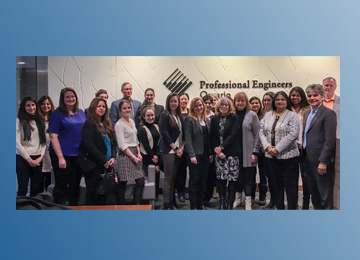
Members of PEO’s 30 by 30 Task Force recently described their efforts to reach 30 by 30 and some of the key challenges they see.

What are some highlights from your 30 by 30 work would you like to share with us?
The PEO 30 by 30 Task Force is in the process of building awareness of the Engineers Canada 30 by 30 initiative and PEO’s 30 by 30 Action Plan. To date, we have held Awareness Sessions for Women, PEO chapters and committees, and employers of engineers. Next, we will be hosting sessions for universities.
What do you see as the key barriers to achieving 30 by 30?
Changing mindsets that resist the fact that women are just as capable as men in practising engineering. It will also be critical that key stakeholders along the pathway to licensure both value the license and are willing to do their part in ensuring that women engineering graduates, both domestically and internationally educated, are encouraged and supported in pursuing licensure.
In striving to achieve the 30 per cent goal, we will also need to shift the focus from downstream recruitment/outreach efforts to what is happening to women engineering graduates and those already practising. To put things in perspective, female students need to be taking Grade 11 science and math pre-requisites for engineering programs, especially physics, right now to be eligible for licensure in 2030.
What are the most important things you've learned as a 30 by 30 Champion that others would benefit from knowing?
It is critical that the 30 by 30 initiative not be seen as a women’s issue, but as an issue of concern for the entire engineering profession, for both women and men. Ownership for this initiative also has to take place at the highest levels in organizations. The Task Force makes a conscious effort to ensure that we have gender balance, and that we include decision-makers and influencers in our engagement activities.
What do you think it will take to achieve 30 by 30 nationwide?
Clearly defined action plans with key metrics to track, collectively, our efficacy and progress. This is an 11-year journey that will take visible leadership and continued perseverance to reach the 30 per cent goal.


